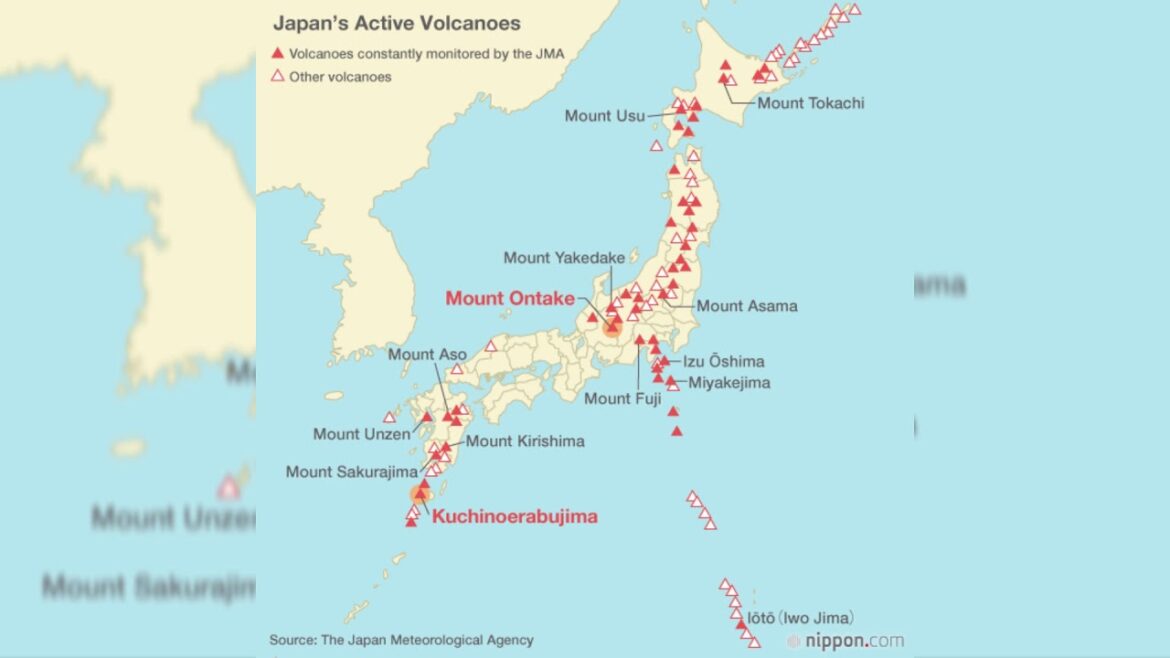Sakurajima (Japanese: 桜島, literally “Cherry Blossom Island”) is an active stratovolcano, formerly an island and now a peninsula, in Kagoshima Prefecture in Kyushu, Japan. The lava flows of the 1914 eruption connected it with the Ōsumi Peninsula. It is the most active volcano in Japan.
As of April 2021, the volcanic activity still continues, dropping volcanic ash on the surroundings. Earlier eruptions built the white sand highlands in the region. On September 13, 2016, a team of experts from Bristol University and the Sakurajima Volcano Research Centre in Japan suggested that the volcano could have a major eruption within 30 years; since then two eruptions have occurred.
Sakurajima is a stratovolcano. Its summit has three peaks, Kita-dake (northern peak), Naka-dake (central peak) and Minami-dake (southern peak) which is active now.
Kita-dake is Sakurajima’s highest peak, rising to 1,117 m (3,665 ft) above sea level. The mountain is in a part of Kagoshima Bay known as Kinkō-wan. The former island is part of the city of Kagoshima which is only 4km across the bay. The surface of this volcanic peninsula is about 77 km2 (30 sq mi).
Sakurajima has a population of a few thousand residents, formerly incorporated as Sakurajima town, with a number of schools, shrines, and shops on the island. It is serviced by the Sakurajima Ferry which runs 24/7. It is a tourist destination known for its onsen, local pottery made from volcanic ash, and produce such as the Sakurajima daikon radish and Sakurajima komikan orange which grow in the immensely fertile volcanic soil.
Sakurajima’s activity became more prominent in 1955, and the volcano has been erupting almost constantly ever since. Thousands of small explosions happen each year, throwing ash to heights of up to a few kilometers above the mountain. The Sakurajima Volcano Observatory was set up in 1960 to monitor these eruptions.
Sakurajima is part of the Kirishima-Yaku National Park, and its lava flows are a major tourist attraction. The area around Sakurajima contains several hot spring resorts. One of the main agricultural products of Sakurajima is a huge basketball-sized white radish (Sakurajima daikon).
On March 10, 2009, Sakurajima erupted, sending debris up to 2 km (1.2 mi). An eruption had been expected following a series of smaller explosions over the weekend. It is not thought there was any damage caused.
An eruption occurred from the Minami-dake summit crater at 5:38 on Sunday, August 9, 2010, sending debris up to 5000 m (16,000 ft).
In 2011 and 2012, Sakurajima experienced several significant eruptions; volcanic activity continued into 2013. Photographer Martin Rietze captured a rare picture of lightning within the ash plume in January 2013 during a magma ejection, which was a NASA astronomy pic of the day in March 2013.
On August 18, 2013, the volcano erupted from Showa crater and produced its highest recorded plume of ash since 2006, rising 5,000 metres high and causing darkness and significant ash falls on the central part of Kagoshima city. The eruption occurred at 16:31 and was the 500th eruption of the year.
In August 2015, Japan’s meteorological agency issued a level 4 emergency warning, which urges residents to prepare to evacuate. Scientists warned that a major eruption could soon take place at the volcano; it eventually did erupt around 20:00 on February 5, 2016.
After a long pause of eruptions at the vent, the eruptions abruptly stopped there and returned to the Showa crater, on April 4, 2016, some 8–9 days preceding major earthquakes on the Median Tectonic Line near Kumamoto, Japan. Then, three months later, on July 26, it spewed volcanic ash 5,000 m (16,000 ft) into the air.
On October 3, 2020, at 07:35 UTC, the volcano erupted once again, this time from the Aira caldera. A volcanic ash advisory for aviation was issued by the Volcanic Ash Advisory Center Tokyo (VAAC) at 07:43 UTC, showing the ash cloud to be stationary and reaching FL100 (10,000 feet).
On July 24, 2022, at 20:05 JST, an explosive eruption occurred at the summit crater of the volcano, and cinders scattered up to 2.5 km from the crater. Following this eruption, at 20:50 JST, the Japan Meteorological Agency raised the eruption alert level from Level 3 to Level 5, the highest level, and urged maximum precaution and evacuation. This was the first time an eruption alert level 5 has been issued for Sakurajima.
On February 9, 2023, an eruption occurred at the Showa crater on Sakurajima at 10:52 JST. The plumes had risen to 1000 meters at 11:10 JST, according to the Kagoshima Meteorological Office.[33] People in a 2-km radius were sent a warning by the local weather observatory against pyroclastic flows and falling rocks. #sakurajima https://youtu.be/Xb9RLJpsRtw

